
Arena of Death is a fantasy combat board game published by Simulations Publications, Inc. (SPI) in 1980.

Arena of Death is a fantasy combat board game published by Simulations Publications, Inc. (SPI) in 1980.
Arena of Death is a game of arena combat using the combat system developed for the first edition of DragonQuest . Acting as gladiators, players take on the combat roles of various fantasy creatures and warriors. [1]
SPI published the fantasy role-playing game DragonQuest in 1980. The combat system was published as a pull-out game, Arena of Death, in Issue #4 of Moves (September 1980). The game was subsequently released as a boxed game. [2]
In Issue 38 of The Space Gamer , Eric Paperman was not overly impressed, saying, "The only people to whom I can recommend this game are fantasy role-players interested in adapting Arena of Death's combat and maneuver rules for use with their FRPG. DragonQuest is probably a better buy; for [a slightly higher price] you get monsters, magic, and other skills, and a slightly more complete combat and character generation system." [1]
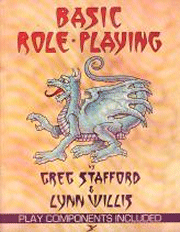
Basic Role-Playing (BRP) is a tabletop role-playing game which originated in the RuneQuest fantasy role-playing game. The BRP standalone booklet was first released in 1980 in the boxed set release of the second edition of RuneQuest. Greg Stafford and Lynn Willis are credited as the authors. A percentile skill-based system, BRP was used as the basis for most of the games published by Chaosium, including Call of Cthulhu, Stormbringer, and Elfquest.

RuneQuest is a fantasy tabletop role-playing game originally designed by Steve Perrin, Ray Turney, Steve Henderson, and Warren James, and set in Greg Stafford's mythical world of Glorantha. It was first published in 1978 by The Chaosium. Beginning in 1984, its publication passed between a number of companies; Avalon Hill, Mongoose Publishing, The Design Mechanism, finally returning to Chaosium in 2016. RuneQuest is notable for its system, designed around percentile dice and with an early implementation of skill rules, which became the basis of numerous other games. There have been several editions of the game.
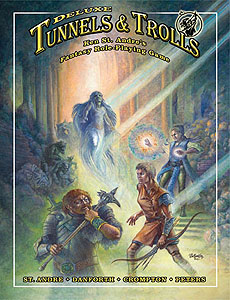
Tunnels & Trolls is a fantasy role-playing game designed by Ken St. Andre and first published in 1975 by Flying Buffalo. The second modern role-playing game published, it was written by Ken St. Andre to be a more accessible alternative to Dungeons & Dragons and is suitable for solitaire, group, and play-by-mail gameplay.

The Fantasy Trip (TFT) is a tabletop role-playing game designed by Steve Jackson and originally published by Metagaming Concepts. In 2019, TFT was republished by Steve Jackson Games as The Fantasy Trip Legacy Edition.

Games Workshop Group is a British manufacturer of miniature wargames, based in Nottingham, England. Its best-known products are Warhammer Age of Sigmar and Warhammer 40,000.
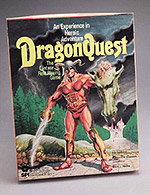
DragonQuest is a fantasy role-playing game originally published by Simulations Publications (SPI) in 1980. Where first generation fantasy role-playing games such as Dungeons & Dragons restricted players to particular character classes, DragonQuest was one of the first games to utilize a system that emphasized skills, allowing more individual customization and a wider range of options.
A role-playing video game is a video game genre where the player controls the actions of a character immersed in some well-defined world, usually involving some form of character development by way of recording statistics. Many role-playing video games have origins in tabletop role-playing games and use much of the same terminology, settings and game mechanics. Other major similarities with pen-and-paper games include developed story-telling and narrative elements, player character development, complexity, as well as replay value and immersion. The electronic medium removes the necessity for a gamemaster and increases combat resolution speed. RPGs have evolved from simple text-based console-window games into visually rich 3D experiences.
Simulations Publications, Inc. (SPI) was an American publisher of board wargames and related magazines, particularly its flagship Strategy & Tactics, in the 1970s and early 1980s. It produced an enormous number of games and introduced innovative practices, changing the course of the wargaming hobby in its bid to take control of the hobby away from then-dominant Avalon Hill. SPI ran out of cash in early 1982 when TSR called in a loan secured by SPI's assets. TSR began selling SPI's inventory in 1982, but later acquired the company's trademarks and copyrights in 1983 and continued a form of the operation until 1987.

Ares was an American science fiction wargame magazine published by Simulations Publications, Inc. (SPI), and then TSR, Inc., between 1980 and 1984. In addition to the articles, each issue contained a wargame, complete with a foldout stiff paper map, a set of cardboard counters, and the rules.
Action role-playing is a subgenre of video games that combines core elements from both the action game and role-playing genre.

Bushido is a Samurai role-playing game set in Feudal Japan, originally designed by Robert N. Charrette and Paul R. Hume and published originally by Tyr Games, then Phoenix Games, and subsequently by Fantasy Games Unlimited. The setting for the game is a land called Nippon and characters adventure in this heroic, mythic and fantastic analogue of Japan's past.
Deathmaze is a board game published by Simulations Publications in January 1980, and designed by Greg Costikyan and Redmond A. Simonsen. It falls into the general category of dungeon crawls, more specifically, dungeon games in which players enter a dungeon, massacre the dungeon dwellers and steal their treasures.

Daredevils is a tabletop role-playing game published by Fantasy Games Unlimited (FGU) in 1982 that is meant to emulate pulp magazine fiction of the 1930s.

High Fantasy is a fantasy role-playing game system originally published by Fantasy Productions in 1978. A second edition in 1981 and several subsequent books were published by Reston Publishing that featured solo adventures using the High Fantasy system. The game received mixed reviews in game periodicals including White Dwarf, The Space Gamer, Different Worlds, Ares, and Dragon.

Heroes of Olympus is a role-playing game first published by Task Force Games in 1981.
Eric Goldberg is an American game designer who has worked primarily on role-playing games.
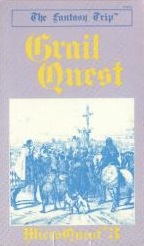
Grail Quest is a solitaire Arthurian fantasy combat adventure published by Metagaming Concepts in 1980 that uses the combat rules from The Fantasy Trip.

Arms Law is a supplement published by Iron Crown Enterprises in 1980 for the fantasy role-playing game Rolemaster.
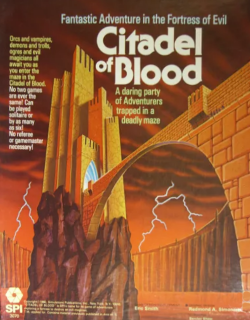
Citadel of Blood, subtitled "Fantastic Adventure in the Fortress of Evil". is a dungeon-crawl board game published by Simulations Publications, Inc. (SPI) in 1980.

Frontiers of Alusia is a 1981 role-playing game supplement for DragonQuest published by SPI.